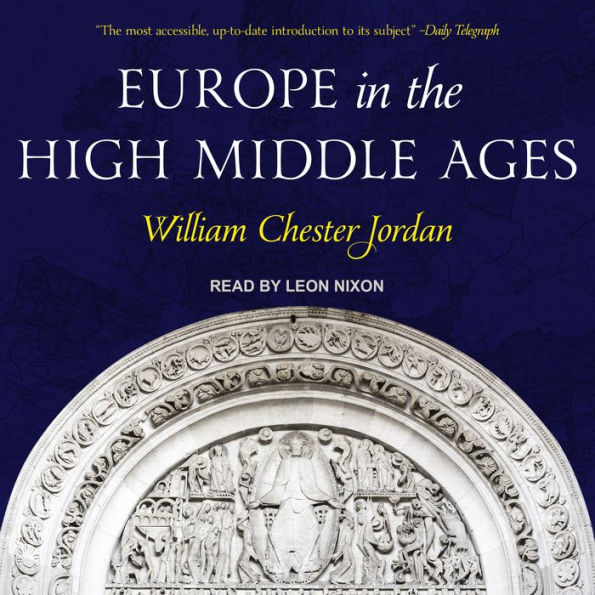A chronicle of high ideals and cherished dreams—as well as famine, plague, holy war, and other apocalyptic horsemen in the making of Europe from the 11th to the 14th centuries. The year 1000, Haskins Medal–winner Jordan (The Great Famine, 2000) writes, saw the arrival of remarkable change in Europe. The lifting of the Dark Ages brought with it a huge gain in population (from two million to ten million in England, from four to fourteen million in German-speaking countries, and so on) and great advances in technology, including the adoption of three-field farming and the heavy plow. All of this led to prosperity and happier times for long-suffering peoples. At the outset of this period, Jordan (History/Princeton Univ.) reminds us, the Church had comparatively little power and influence: "To be a Catholic in the year 1000 required little change in traditional behavior, in part because there were so few people who were actively monitoring behavior on behalf of that vague body so conveniently yet deceptively referred to under the monolithic label, the Church." Three hundred years later, things were different: Political and ecclesiastical powers were centralized, orthodoxies were in place, crusades had been fought, heretics had been routed and burned. In a wide-ranging narrative that embraces most of the continent and takes in enlightened rulers (Stephen of Hungary, Henry II), adventurers (Richard Lion-heart, Tancred), despots (Fulk Nerra, Henry III), and assorted saints and sages (Dominic, Thomas Aquinas), Jordan charts the course of this growing centralization and its eventual collapse under the weight of famine, disease, incompetence, and gunpowder. He writes elegantly and ironically ("therewas curiously little pacifism in the High Middle Ages"), giving the reader a broad but not dumbed-down view of medieval society and its complexities, which must have seemed to contemporaries very bewildering indeed. A splendid start to Penguin’s History of Europe series and a first-rate work in its own right.
It was an age of hope and possibility, of accomplishment and expansion. Europe's High Middle Ages spanned the Crusades, the building of Chartres Cathedral, Dante's Inferno, and Thomas Aquinas. Buoyant, confident, creative, the era seemed to be flowering into a true renaissance-until the disastrous fourteenth century rained catastrophe in the form of plagues, famine, and war.
In Europe in the High Middle Ages, William Chester Jordan paints a vivid, teeming landscape that captures this lost age in all its glory and complexity. Here are the great popes who revived the power of the Church against the secular princes; the writers and thinkers who paved the way for the Renaissance; the warriors who stemmed the Islamic tide in Spain and surged into Palestine; and the humbler estates, those who found new hope and prosperity until the long night of the 1300s. From high to low, from dramatic events to social structures, Jordan's account brings to life this fascinating age.
1100733879
In Europe in the High Middle Ages, William Chester Jordan paints a vivid, teeming landscape that captures this lost age in all its glory and complexity. Here are the great popes who revived the power of the Church against the secular princes; the writers and thinkers who paved the way for the Renaissance; the warriors who stemmed the Islamic tide in Spain and surged into Palestine; and the humbler estates, those who found new hope and prosperity until the long night of the 1300s. From high to low, from dramatic events to social structures, Jordan's account brings to life this fascinating age.
Europe in the High Middle Ages
It was an age of hope and possibility, of accomplishment and expansion. Europe's High Middle Ages spanned the Crusades, the building of Chartres Cathedral, Dante's Inferno, and Thomas Aquinas. Buoyant, confident, creative, the era seemed to be flowering into a true renaissance-until the disastrous fourteenth century rained catastrophe in the form of plagues, famine, and war.
In Europe in the High Middle Ages, William Chester Jordan paints a vivid, teeming landscape that captures this lost age in all its glory and complexity. Here are the great popes who revived the power of the Church against the secular princes; the writers and thinkers who paved the way for the Renaissance; the warriors who stemmed the Islamic tide in Spain and surged into Palestine; and the humbler estates, those who found new hope and prosperity until the long night of the 1300s. From high to low, from dramatic events to social structures, Jordan's account brings to life this fascinating age.
In Europe in the High Middle Ages, William Chester Jordan paints a vivid, teeming landscape that captures this lost age in all its glory and complexity. Here are the great popes who revived the power of the Church against the secular princes; the writers and thinkers who paved the way for the Renaissance; the warriors who stemmed the Islamic tide in Spain and surged into Palestine; and the humbler estates, those who found new hope and prosperity until the long night of the 1300s. From high to low, from dramatic events to social structures, Jordan's account brings to life this fascinating age.
24.99
In Stock
5
1
24.99
In Stock

Editorial Reviews
Product Details
| BN ID: | 2940173911384 |
|---|---|
| Publisher: | Tantor Audio |
| Publication date: | 10/29/2019 |
| Edition description: | Unabridged |
Videos

From the B&N Reads Blog

